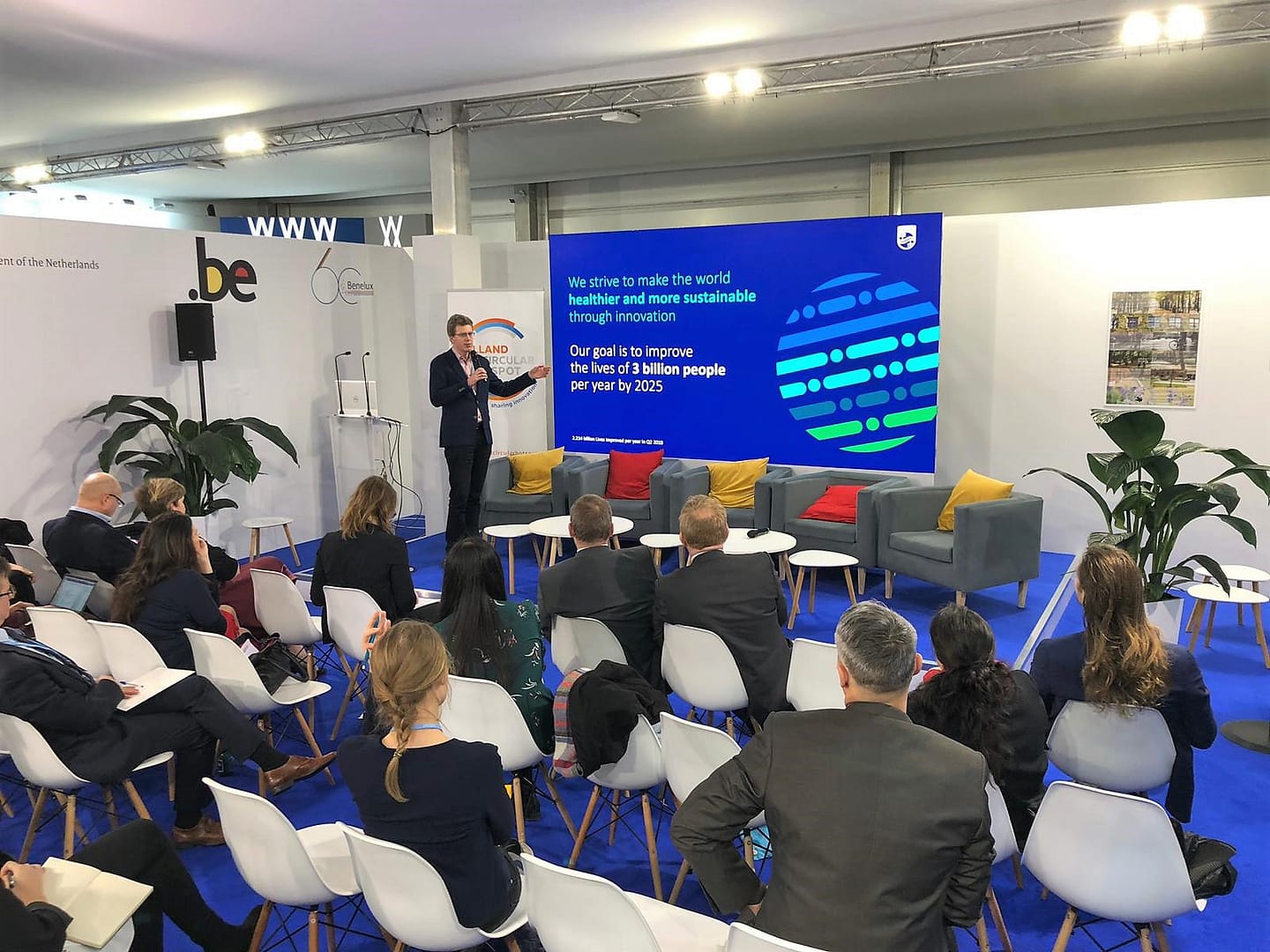At the COP24 climate summit in Katowice on December 7, our founder Eva Gladek presented Metabolic & Copper8’s updated research on the raw materials needed to achieve the Paris climate agreement targets. Our report found the global production of some rare earth metals used in renewable energy technologies needs to grow as much as twelvefold by 2050.
Gladek was one of a range of figures from the business and science communities invited to speak at the COP24 side event Circular Economy: the missing link in the climate discussion, which sought to highlight how transitioning to a circular economy that decouples economic growth from the use of natural resources and ecosystems by using those resources more effectively can help slash carbon emissions.
In her presentation and participation in the discussion panel, Gladek highlighted how the world needs to plan ahead for production of the rare earth metals used in solar panels and wind turbines. The report, which used Dutch renewable energy needs as a case study, found it can take between 10-20 years to open a new mine, that the recycling rates of these metals are very low, and that geopolitical complications could arise out of China’s dominance of rare metal supply. “It is essential for us to manage materials in a circular fashion in order to ensure that we have enough for the technologies critical to a low-carbon future,” Gladek said.
Circular solutions to cut carbon emissions
Other work presented at the event included Finnish Innovation Fund Sitra’s recent study The Circular Economy – a Powerful Force for Climate Mitigation, made in collaboration with European Climate Foundation and Material Economics. “Making better use of the materials that already exist in the economy, using circular business models and having greater material efficiency can take EU industry halfway towards net-zero emissions in an economically attractive way,” said Sitra circular economy project director Kari Herlevi.
Harald Tepper, Program Lead Circular Economy at Philips, spoke on the Dutch multinational technology company’s aims to deliver 15% of total revenues from circular products and services by 2020. “Furthermore, the company has pledged that it will take back and repurpose all the large medical systems that its customers are prepared to return to it by 2020, and that it will extend these practices to all professional equipment by 2025,” he said.
Jakub Wójcik, Vice-Chairman of Izodom Company, presented on saving 9m tonnes of CO2 by using a circular approach to thermal insulation for 19,000 buildings. Arve Ulriksen, CEO of Mo Industripark, spoke on achievements such as the recovery of heat from the industry equivalent to the annual energy consumption of the Norwegian city of Mo i Rana’s 24, 000 inhabitants. The recycled energy is used for a range of purposes including district heating, ensuring ice free streets and heated sports arenas, hospital and other public buildings.
Callum Blackburn, Head of Policy, Research and Evaluation at Zero Waste Scotland, said: “The circular economy isn’t just about tackling climate change – it will also be a boost to local economies. We have identified a wide range of exciting business opportunities in the emerging circular economy, which could be worth £1bn to the economy of two of Scotland’s regions alone.”

From the event several key recommendations were made:
Integrate Circular Economy and Climate Policies
- Many governments have adopted legislation to improve waste management—just one aspect of circular economy and often not tied to climate policy—but few have adopted legislation that tries to reduce waste holistically and at the source, or in conjunction with climate action. Circular economy policies should be targeted at the source of waste include lifetime extension, modular design, design for disassembly, material and resource passports, and international cooperation on supply chains.
- As industry associations and the European Commission consider new mid-century ‘roadmaps’ for industry, they should include circular economy measures for cost-effective ways to achieve deep emissions cuts.
Policy levers for a circular economy and climate measures can work in tandem
- More emphasis on design. In the design phase there is a high likelihood 80% of the environmental footprint can be determined.
- Incentives for green public and private procurement help create demand for circular products. Public procurement is 20% of EU GDP and can create a huge pull factor for new circular innovations.
- Extended producer responsibility schemes introduce life-cycle thinking in manufacturing, in supporting the marketing of better products, and in promoting responsible interaction between producers and consumers. When set up in close alignment between government, producers and taking consumers into account they have proven to be effective in the European Union and in front-running countries such as France.
- Supportive tax reform can make it more attractive for companies to adopt circular business models, even if these are more labor-intensive.
- Use metabolic approaches to identify mitigation options. Capacity building should step away from a focus on the sources of emissions to developing an understanding of how resources, both raw materials and fuels, are used to deliver services to society. This requires a metabolic analysis, a mapping of the flows and stocks of materials and energy, aiming for improvement of the system and the way it responds to societal needs.
- Aligning standards and definitions across borders, for example regarding a waste and a resource status.
Cities as places of action
Whereas national governments set the ambitions and create the boundaries and companies have to do the major part of the scaling-up, the place where circular action can start and grow is often in cities. Local governments should bring stakeholders together, share best practices, show the potential and set an example.
System change
The circular economy is a new way of designing, producing, consuming and dealing with waste. It is about innovation (like the tremendous opportunities of digitization) and new cross-sectoral collaboration. The greenhouse gas emission (GHG) reduction potential of the circular economy is not cost driven but based on sound and inspiring business models that have significant potential in every market segment and can work both in developed and developing nations. A circular economy is also an opportunity to create jobs and raise standards of living. It requires that we continue to raise awareness and educate the leaders for tomorrow.
The COP 24 event was initiated by the Holland Circular Hotspot foundation and organized together with Zero Waste Scotland, Sitra, Circular Norway, Poland Circular Hotspot and Luxembourg Circular Hotspot.






